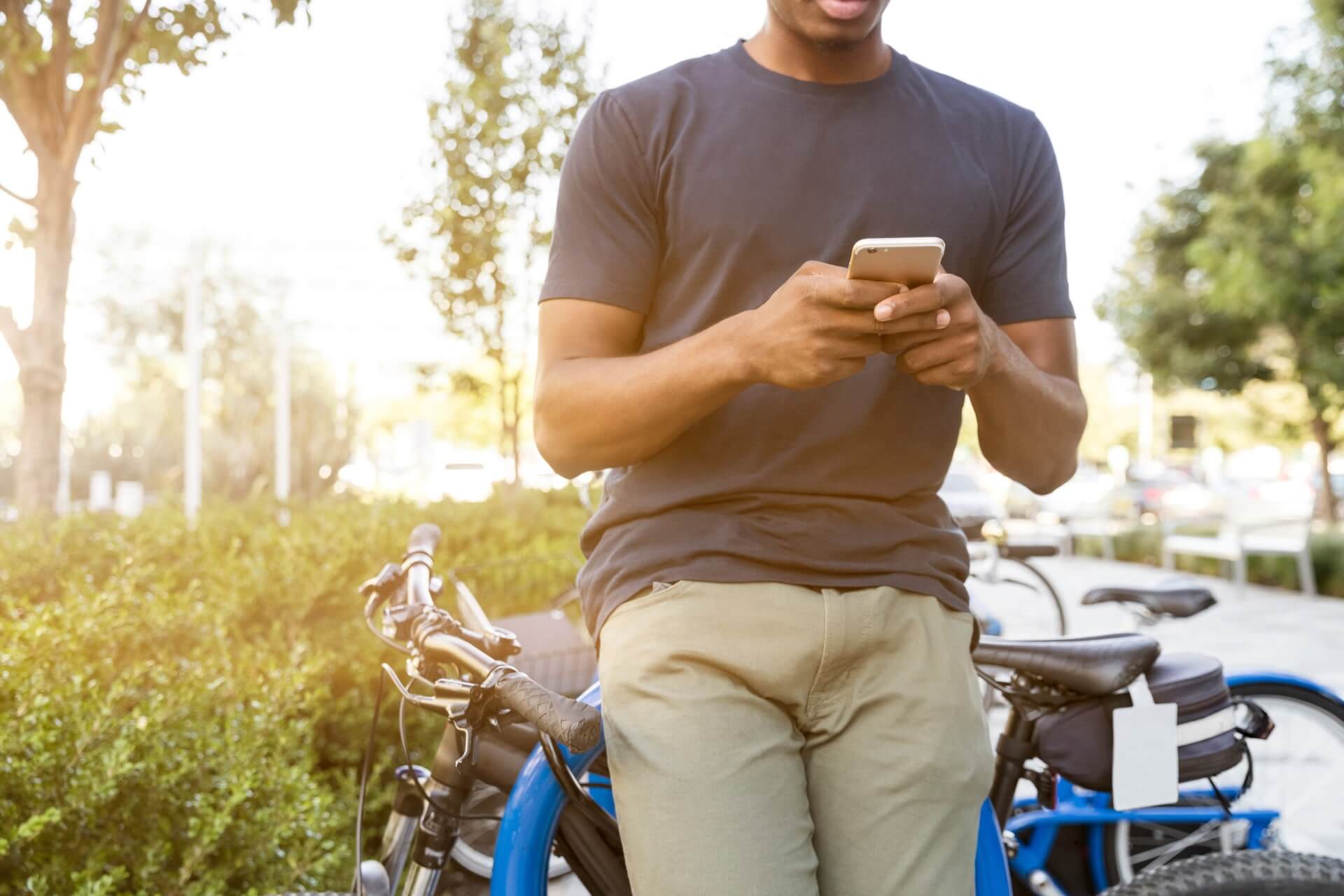
Les avancées technologiques peuvent faire des miracles. Pour les 466 millions de personnes dans le monde souffrant d’une perte auditive invalidante ( OMS ), les smartphones sont devenus un outil essentiel pour faciliter les interactions sociales grâce à la perception de la parole.
Aujourd’hui, 95 % des personnes sourdes et malentendantes utilisent un smartphone au quotidien dans les pays développés. De nombreuses applications contribuent à éliminer les principaux obstacles à la communication qui entravent le quotidien de millions de personnes sourdes et malentendantes à travers le monde.
Pour vous aider à démarrer, nous avons sélectionné pour vous les 5 meilleures applications de 2022 pour aider vos visiteurs malentendants à vous contacter, à communiquer sur place et à bénéficier des services disponibles. Cette liste non exhaustive ne remplace pas les dispositifs déjà disponibles dans votre établissement, comme les boucles magnétiques, mais constitue plutôt un complément optionnel pour mieux accueillir les personnes sourdes ou malentendantes dans votre établissement ou lors de réunions de concertation.
Paramètres d’accessibilité du smartphone
Avant de se précipiter sur Google Play ou l’App Store, il est important de vérifier auprès de l’utilisateur que les paramètres d’accessibilité de son smartphone sont bien configurés. De bons réglages sont plus efficaces qu’une application qui surcharge l’appareil.
Les fonctionnalités des téléphones sont souvent sous-utilisées en raison du manque de communication entre les systèmes d’exploitation et de leur constante évolution. Elles sont pourtant simples à activer et très utiles. Voici celles que vous devez communiquer à vos équipes si nécessaire cette année.
Tout d’abord, renseignez-vous sur le modèle du téléphone . La personne possède-t-elle un iPhone ? Pour les utilisateurs d’iPhone 5 ou ultérieurs, le téléphone inclut plusieurs options d’accessibilité de base, telles que :
⊗ Contrôle du volume
⊗ Écoute en direct pour les personnes malentendantes afin de mieux percevoir leur interlocuteur lors d’une conversation, même s’il se trouve à l’autre bout de la pièce ou dans un environnement bruyant. Le son peut être transmis à des aides auditives compatibles Made for iPhone, des AirPods ou des Powerbeats.
⊗ Audio mono pour les personnes malentendantes d’une oreille. Les enregistrements stéréo diffusent des informations audio distinctes dans chaque oreille. L’audio mono vous permet d’entendre les mêmes informations dans les deux oreilles.
⊗ La configuration des protocoles RTT et TTY pour passer des appels sous forme de texte en direct.
⊗ Alertes visibles et vibrantes pour éviter de manquer des appels, des messages et des notifications avec la possibilité de choisir plusieurs options de vibration ainsi qu’une lampe de poche.
⊗ Siri en tapant la question souhaitée.
Des raccourcis peuvent être configurés pour simplifier l’accès aux fonctionnalités par un triple clic. Invitez les utilisateurs à effectuer la dernière mise à jour de leur appareil pour accéder aux dernières fonctionnalités.
Sur les téléphones Android, les fonctionnalités natives sont moins nombreuses, mais complétées par des applications téléchargeables. À ce jour, les smartphones fonctionnant sous Android offrent les fonctionnalités d’accessibilité suivantes pour les personnes sourdes et malentendantes :
⊗ Transcription instantanée pour suivre une conversation en direct dans plus de 70 langues et participer rapidement à la conversation grâce à la synthèse vocale.
⊗ Sous-titres avec possibilité de choisir les préférences des sous-titres à utiliser (langue, texte et style).
⊗ Sous-titres instantanés : cette fonctionnalité est automatique pour tout le contenu multimédia en cours de lecture sur les appareils Google Pixel uniquement.
⊗ Compatibilité avec les aides auditives qui vous permet de coupler des aides auditives avec un appareil Android pour entendre plus clairement.
⊗ Messagerie instantanée en temps réel (RTT) compatible avec les ATS. Comme sur iPhone, cette option permet de saisir du texte pour communiquer en direct pendant un appel.
5 applications essentielles pour les personnes sourdes et malentendantes
Une fois votre téléphone correctement configuré, il est temps d’installer des applications adaptées à votre utilisation. Nous avons sélectionné pour vous six applications gratuites et utiles pour améliorer l’accessibilité en 2022 et communiquer facilement avec les personnes sourdes et malentendantes.
Ava
Une application de transcription instantanée qui retranscrit en direct les propos d’un groupe de personnes. Chaque participant installe l’application sur son smartphone et, grâce au microphone, les conversations sont transcrites. Cette application permet aux personnes sourdes ou malentendantes de suivre distinctement une conversation au sein d’un groupe sans avoir à lire sur les lèvres.
Utile pour les utilisateurs d’iPhone qui n’ont pas accès à la célèbre fonctionnalité native de transcription instantanée de Google lors de vos réunions de consultation.
Disponible sur iOS et Android .
RogerVoice
L’application française mondialement connue créée en 2013 par Olivier Jeannel propose deux options.
La première fonctionnalité est la transcription en direct des conversations téléphoniques dans plus de 100 langues, ainsi que la possibilité de répondre par synthèse vocale. Les personnes sourdes, malentendantes ou ayant des difficultés d’élocution peuvent utiliser le téléphone pour converser avec leur interlocuteur et recevoir un texte dactylographié de ses propos.
L’application va plus loin en proposant de passer des appels grâce à l’aide d’interprètes LSF diplômés et de codeurs LPC diplômés (en France uniquement). Une version gratuite offre jusqu’à une heure d’appel par visio-interprétation.
Une application utile pour les personnes sourdes ou malentendantes qui souhaitent demander des informations sur votre lieu à distance.
Disponible sur iOS et Android.
Amplificateur de son
L’application Sound Amplifier pour Android est l’équivalent de l’option « Écoute en direct » incluse dans les paramètres de base de l’iPhone. Elle offre toutefois des fonctions plus avancées pour le réglage du volume sonore et la suppression des bruits de fond.
L’application Sound Amplifier améliore la qualité audio des appareils Android avec un casque, pour une expérience d’écoute plus confortable et naturelle. Elle amplifie et amplifie les sons du monde réel.
Cette application peut être très utile si votre lieu dispose d’un environnement sonore médiocre.
Disponible sur Android . Notez que l’application Sound Amplifier fait partie des paramètres natifs des téléphones Google Pixel.
TapSOS
L’application britannique Tap SOS permet aux personnes sourdes et malentendantes d’entrer en contact avec les services d’urgence de manière non verbale. En créant un profil incluant leurs antécédents médicaux, les secouristes peuvent prodiguer les meilleurs soins en cas d’urgence.
Lors de la connexion avec un service d’urgence, l‘application localise l’emplacement exact et envoie toutes les données stockées dans le profil de l’utilisateur en quelques secondes.
L’application a remporté le prix Digital Health Award 2018 en tant que méthode la plus efficace pour tous les utilisateurs de smartphones pour contacter les services d’urgence en situation de détresse.
Disponible sur iOS et Android.
Visionneuse de sous-titres
Grâce aux microphones des smartphones, l’application Subtitle Viewer permet aux personnes sourdes et malentendantes de visualiser des sous-titres en différentes langues en direct sur leur téléphone. Les sous-titres s’affichent en temps réel et le texte est mis en surbrillance.
L’application se synchronise avec la télévision et les films au cinéma. D’autres applications similaires sont disponibles sur le marché et peuvent accueillir les personnes malentendantes dans vos cinémas si les séances ne sont pas sous-titrées.
Disponible sur iOS et Android.
Comme vous pouvez le constater, les smartphones peuvent être d’excellents outils à portée de main pour aider les personnes malentendantes à mieux vivre. Qu’ils facilitent l’accès au marché du travail, à la culture, aux soins médicaux et aux services publics, les technologies actuelles favorisent les liens sociaux entre les personnes sourdes et malentendantes et le reste de la population, sans pour autant remplacer le contact humain.
Grâce à ces applications, la communication entre les personnes sourdes et malentendantes et les personnes entendantes n’a jamais été aussi simple !
Si vous souhaitez en savoir plus sur la déficience auditive, consultez ces articles :
Ce que vous devez faire pour garantir l’accessibilité des personnes sourdes dans les lieux publics
Personnes malentendantes : une multitude de profils pour des besoins différents
Mis à jour le 28 décembre 2021 / Publié le 17 janvier 2020
media

Phone functionalities are often underused due to the lack of communication by operating systems and their constant evolution. They are however simple to activate and highly useful.
writer

Zoe Gervais
Content Manager
stay updated
Get the latest news about accessibility and the Smart City.
other articles for you

Open Data Is Key to Fostering Universal Accessibility
Open data represents an opportunity for cities to reach universal accessibility. It shows the missing links of the mobility chain.
Our Audio Beacons Guide the Blind and Visually Impaired at the Helsinki Subway
The Helsinky subway improved their audio signage system by installing on demand and remotely activated audio beacons.
7 Good Reasons to Install Audio Beacons at Your Public Transport Network
Audio beacons are an efficient way to provide more autonomy to blind and visually impaired people. They can easily use public transport.

Will Remote Activation Become the Norm for Accessible Pedestrian Signals?
More and more cities like New York have been exploring remote activation to trigger accessible pedestrian signals.
share our article!
more articles

Disability Statistics in the US: Looking Beyond Figures for an Accessible and Inclusive Society
Disability Statistics in the US: Looking Beyond Figures for an Accessible and Inclusive Society Around 61 million adults in the United States live with a disability. Diving into disability statistics in the US will help us know exactly who is concerned and what...
Our Audio Beacons Guide the Blind and Visually Impaired at the Helsinki Subway
Our Audio Beacons Guide the Blind and Visually Impaired at the Helsinki SubwayOur audio beacons equip the new line of the Helsinki subway in Finland. They help blind and visually impaired people locate the points of interest of a station. For users with visual...

Will Remote Activation Become the Norm for Accessible Pedestrian Signals?
Will Remote Activation Become the Norm for Accessible Pedestrian Signals?Without pushbutton, there are no accessible pedestrian signals. That’s how APS work in the U.S. But more and more cities have been exploring remote activation like New York City. The Department...

Hearing Impaired People: a Multitude of Profiles for Different Needs
Hearing Impaired People: a Multitude of Profiles for Different Needs Did you know that hearing impaired people have several profiles and that the way they identify themselves is important? You may be familiar with deaf and hard of hearing people but for each of...
NEVER miss the latest news about the Smart City.
Sign up now for our newsletter.
Unsubscribe in one click. The information collected is confidential and kept safe.
powered by okeenea
The French leading company
on the accessibility market.
For more than 25 years, we have been developing architectural access solutions for buildings and streets. Everyday, we rethink today’s cities to transform them in smart cities accessible to everyone.
By creating solutions ever more tailored to the needs of people with disabilities, we push the limits, constantly improve the urban life and make the cities more enjoyable for the growing majority.


